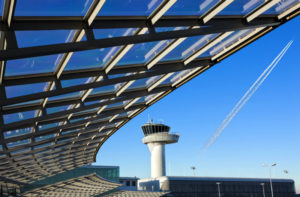 An Air Traffic Control Tower.
An Air Traffic Control Tower.
Xanadu 212 – this would be a call sign specifically used by AirAsia X pilots on a flight to a destination in Australia (AirAsia X has designated that flights into Australia begin with the number ‘2’). A call sign is an alphanumeric code that uniquely identifies a carrier, and is used for radio communication between the aircraft and the control tower. Since airlines all over the world use English as the official language of communication, regardless of the native tongue of the pilots and air traffic controllers, all call signs are therefore generally in English.
An airline’s call sign is usually short, simple and often associated in some way with the airline. While some call signs are clearly relatable to a particular airline, others may not be immediately obvious. There are many instances when airlines don’t use a call sign that reflects their name; in fact, call signs such as ‘Speed Bird 1’, ‘Clipper 2’ and ‘Dynasty 123’ have no direct relevance to the airlines they are meant to identify. In reality, call signs are only used in communications between the cockpit crew and air traffic controllers, so no one else really knows the actual call sign belonging to a specific aircraft, unless they are eavesdropping on the conversation!
There are many reasons for airlines to choose a call sign that is distinct from their name – aside from the element of uniqueness, an unusual or special call sign provides clarity, thereby avoiding ambiguity, which can lead to confusion. Pilots are trained to communicate using the complete call signs of their respective airlines, as usage of partial call signs, for example, where only the numerals are mentioned, may result in instructions from the ATC (air traffic control) being acknowledged by the wrong airline. In short, unique and specific call signs help keep the skies safer by preventing mix-ups during radio communications between the cockpit crew and the control tower.
EXCLUSIVE COVER
In the US, America West Airlines chose ‘Cactus’ as its call sign. This was not just to signify the airline’s headquarters at Tempe, Arizona, in the area of Sonoran Desert, which is home to the giant saguaro cactus. The call sign ‘Cactus’ also allowed America West Airlines to be clearly distinguished from American Airlines, which uses the call sign ‘American’.
‘Cactus’ was retained as the call sign even when America West Airlines merged with US Airways. Cactus 1549 brings to mind the successful ditching (an aviation term used for the landing of an aircraft on water) of the US Airways Airbus A320, by the heroic Captain Chesley ‘Sully’ Sullenberger. The incident, which received worldwide media attention, even prompted a Hollywood movie called Sully starring the renowned Tom Hanks. In January 2009, US Airways Flight 1549 splash-landed in the Hudson River in New York City after a bird strike. The call sign ‘Cactus’ became well-known when the FAA (Federal Aviation Administration) released the official cockpit recordings, where Captain Sully could be heard referring to the flight as ‘Cactus 1549’.
In Asia, there are many Chinese airlines such as China Airlines, Air China, China Xinhua Airlines, China Southern Airlines and China Eastern Airlines. Call signs for these airlines can be confusing when spoken over the skies, especially by pilots whose mother tongue is not English. Because of this, China Airlines chose ‘Dynasty’ as its call sign to mitigate misunderstandings during radio communications.
AirAsia’s call sign is ‘Red Cap’ – a name inspired by the signature red cap of the airline’s dynamic Group CEO, Tony Fernandes, who is almost never seen without it! Today, this call sign for AirAsia’s new Airbus A320neo and the rest of its fleet is heard all over the skies. AirAsia X, on the other hand, chose ‘Xanadu’ as its call sign to symbolise utopia, as a reflection of the dream destinations it flies to, which include Tokyo, Sydney, Tehran, and most recently, Hawaii!

THE FORCE OF ONE
Many of you would be familiar with one of the most popular call signs – Air Force One – which is reserved for the President of the United States, and is used for any presidential aircraft. When the First Family flies without the President, the call sign used is ‘Air Force One Foxtrot’, and the call sign for a flight with the Vice President on board is ‘Air Force Two’.
When Donald Trump became the 45th US President, ‘Air Force One’, referring to the official Boeing 747 presidential jet, did not impress him much. In fact, the President still preferred his personal Boeing 757, which the public began calling ‘Trump Force One’. And, it’s no wonder, as the President is said to have spent a small fortune on equipping his airliner with every available luxury, making his private Boeing 757 the eighth most expensive plane in the world today!
FANCIFUL PURSUIT
As you take to the skies in a ‘Xanadu’ or ‘Red Cap’ flight, I hope you find this month’s whimsical article entertaining. Here’s wishing you a pleasant, memorable journey!
Posted: 09.08.17